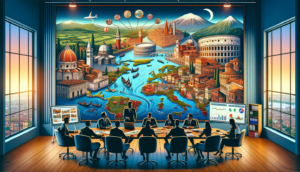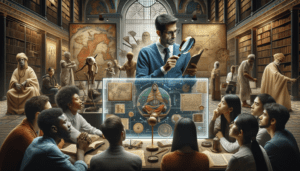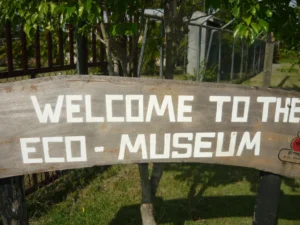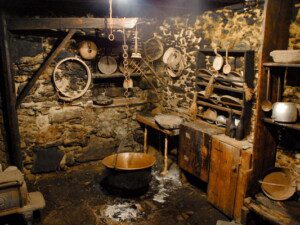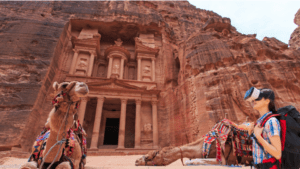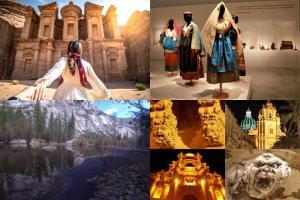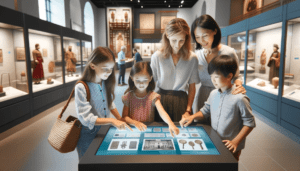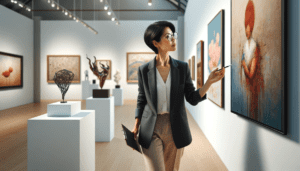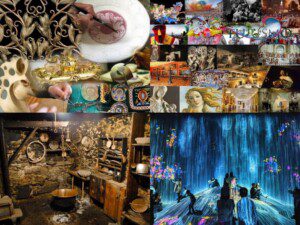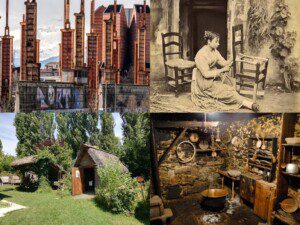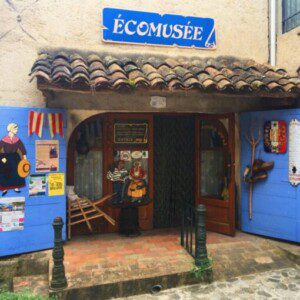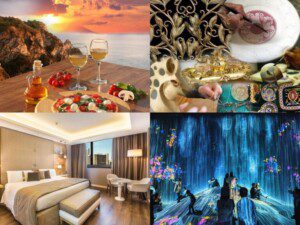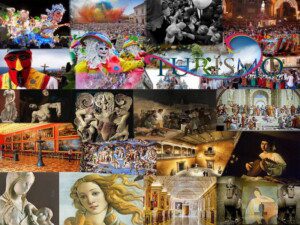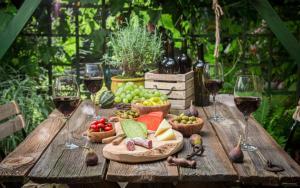Evaluation of the Quality of Experiences
Version 3.0 (Methodology attached to Experiential Quality Mark ®)

Premise
The final quality of an experiential path is not only linked to the quality factors but must also take into account other moments which concern, for example, the very context of the organization offering the experience, as well as other activities such as: planning, "commissioned" design on stage” of experiences and evaluation and improvement activities. Therefore, organizations that provide experiential offers, in order to monitor and maintain a high quality level of their experiential events, should adapt their organizational system by implementing a real Experience Management System (EMS).
Note: The terms “experiential path”, “experiential offer”, “experiential event” or even “experience” are to be considered, in some cases, synonymous.
Type and levels of experience
Classification of Experiences
- Experiences: memorable events that involve individuals on a personal level [Pine and Gilmore – 1999].
- Multisensory experiences: Experiences that see a polysensory involvement ((involvement of at least two or more senses: sight, hearing, touch, smell, taste) (Ignazio Caloggero – 2019-2023)
- Cultural Experience: Experience multisensory that allows you to deepen your knowledge of local identity elements”
A first important distinction is based on the evaluation of whether the experience offered is cultural, focused on knowledge of local identity elements, or whether it is purely commercial. However, the classification of experiential activities should not be interpreted rigidly, as an experience can be culturally significant while having a commercial approach. What determines the classification as cultural or commercial is, in fact, the predominant approach.
Repertoire of Experiential Activities
Another aspect to take into consideration is to identify the types of activities that constitute the scope of application of experiential offers.
Repertoire of Experiential Activities (Rev 1.3):
- Dinner Experience (DIE): Food and wine experiences
- Show Cooking Experience
- Sensory Dinner Experience
- Location Dinner Experience
- Narrative Dinner Experience
- Dinner Show Experience
- Art Dinner Experience
- School Dinner Experience
- Guest Experience (GUE): Experience related to the hospitality sector
- Sensory Guest Experience
- Narrative Guest Experiences
- Location Guest Experience
- Seaside Village Experience
- Farmhouse Experience
- Glamping Experience
- Integrative Guest Experiences
- Cultural Heritage Experience (CHE): Experiences related to Cultural Heritage
- Food and Wine Experience
- Heritage Sides Experience
- Intangible Cultural Heritage Experience
- Cultural Expositive Experience
- Museum/Ecomuseum Experience
- Immersive Art Experience
- Cultural Entertainment Experience
- Cultural Learning Experience
- Heritage Interpretation Experience
- Roots Tourism Experience
- Open Air Experience (OAE): Experiences in close contact with nature or outdoors, also known by the term Outdoor Experience
- Trekking and Hiking Experience
- Bike Experience
- Diving Experience
- Speleology Experience
- River Experience
- Horse Experience
- Donkey Experience
- Animal Experience
- Marine Life Experience
- Flight Experience
- Fishing Tourism Experience
- Wellness Experience (WLE): Experiences related to psycho-physical well-being.
- Entertainment and Show Experience (ESE): Playful experiences in the various sectors of tourism and leisure
- Sports Experience (SPE): Experiences related to sporting activities: Activities where guests participate actively by practicing sports themselves.
- Experiential Marketing (EMA): Experiences mainly of a commercial nature offered by shops, shop centers, eat & drink, etc.
The classification of experiential activities should not be seen in a strict sense as a type of experience can fit into more than one category. For example, Glamping Experiences and in some cases Farmhouse Experiences are also considered Open Air Experiences which in the current revision of the repertoire of experiential activities, for practical reasons and to highlight the aspect linked to hospitality, have been included within of the Guest Experience category. The same goes for Sport Experiences, in particular for those sports in direct contact with nature for which I have currently foreseen their own category. However, the Open Air Experience has close contacts with many other open field experiences included in other categories (Dinner Experiences in the trees or in the midst of nature, Cultural Heritage Experiences and Wellness Experiences in naturalistic sites, etc.)
In many cases the relationship between the different types of experiences is very close as in the case of the Seaside Village Experiences (Ichthyic tourism), Dinner Experiences, Guest Experiences and Open Air Experience (Fishing tourism) the placement in one or the other category was a also a choice of convenience, trying to take into account, in the presence of multiple approaches, the prevailing one.
For experiences it is possible to establish three levels of increasing experience;
Experiences (mainly commercial in nature)
- Experience: “It is a multisensory experience, which has unique characteristics”
- Authentic Experience: “Multisensory experience, unique, thematic, based on human relationships and which provides for the direct participation of guests in the activities that make up the experience"
- Full Experience (or Excellence):"It is a multisensory, unique, thematic, aesthetic, immersive and entertaining experience, based on human relationships and which provides for the direct participation of guests in the activities that make up the experience"
Cultural experiences
- Cultural Experience: “It is a multisensory experience, which has unique characteristics and which allows you to deepen your knowledge of local identity elements”
- Authentic Cultural Experience: "It is a multisensory, unique, thematic experience based on human relationships, which allows the understanding of elements of local identity through the direct participation of guests in the activities that make up the experience"
- Full Cultural Experience (or Cultural Experience of Excellence):“It is a multisensory, unique, thematic, aesthetic, immersive and entertaining experience, based on human relationships, which allows the understanding of elements of local identity through the direct participation of guests in the activities that make up the experience”
Levels of Experience are related to the level of application of the principles of Experience.
-
-
- 1: Multisensoriality
- 2: Local identities
- 3: Uniqueness
- 4: Human relationships
- 5: Direct participation
- 6: Experiential learning
- 7: Thematic approach
- 8: Aesthetic approach
- 9: Entertainment
- 10: Immersion
-
Typology of experiences and applied principles
- Experience
- Experience: Principles 1, 3
- Authentic Experience: Principles 1, 3, 4, 5, 7
- Full Experience: Principles 1, 3, 4, 5, 7, 8, 9, 10
- Cultural experiences
- Cultural Experience: Principles 1, 2, 3
- Cultural Experience Principles 1, 2, 3, 4,5, 6, 7
- Full Cultural Experience: Principles 1, 2, 3, 4, 5, 6, 7, 8, 9, 10
The VQE Method (Evaluation of Experiential Quality)
The VQE Method (Experiential Quality Evaluation) is based on the evaluation of some requirements indicated in the technical specification VQE-01 “Experience Management System: Requirements and Guide for Use”.
The 40 indicators of version 3.0 linked to these requirements are categorized into areas that correspond to points 4 to 10 of the VQE-01 specification. In square brackets the number of indicators:
- CO (4): Context of the Organization [4]
-
- Understanding of the organization and its context
- Understanding the needs and expectations of interested parties (stakeholders
- LE (5): Leadership [2]
-
- Roles, responsibilities and authorities
- PI (6): Management System Planning [3]
-
- Risks and Opportunities
- Experiential goals
- UP (7): Support [3]
-
- Human resources
- Expertise
- AO (8): Operational Activities [21]
- Planning
- Staging
- Experiential Principles
- Control services and products supplied from outside
- VA (9): Evaluation [5]
- Monitoring, measurement and evaluation
- Perceived quality
- MI (10): Improvement [2]
- Non-compliance and corrective actions
- Continuous improvement
The VQE method was implemented by AIPTOC - Italian Association of Tourism Professionals and Cultural Operators, in collaboration with the Helios Study Center
The VQE self-assessment methodology is made available to all organizations wishing to measure their organizational capacity in the provision of experiential offers. The EQA methodology can be used by an organization:
- Self evaluation: as a self-assessment tool for measuring the quality of one's experiential offerings
- Obtaining the Experiential Quality Mark ®
Each organization can freely decide which indicators to adopt, the Organizations that wish to obtain the Experiential Quality Mark should take into account all applicable requirements based on the type of experience and experiential level offered.
Some requirements may not apply (NA) to the operational reality of some organizations. In this case the requirements do not apply and will not affect the awarding of the Mark or Quality Certificate.
Note: It is believed not to use the term "Certification", since it is commonly used by Certification Bodies accredited by national accreditation bodies (such as ACCREDIA) or belonging to the European network (EA - European Cooperation for Accreditation) or international network (IAF - International Accreditation Forum) certification. Although there are currently no Quality of Experience certifications issued by bodies accredited by the aforementioned bodies, we believe it is appropriate, first and foremost for ethical reasons, to avoid ambiguity and possible terminological conflicts.
4. CO: CONTEXT OF THE ORGANIZATION
Understanding of the organization and its context
- CO1: Has the Organization determined the external and internal factors that could impact its ability to achieve the objectives intended for its experiences?
- CO2: Is information regarding external and internal factors and interested parties subjected to periodic monitoring and related review?
Understanding stakeholder needs and expectations
-
- CO3: Has the Organization determined the interested parties (stakeholders) in the experiential events?
- CO4: Has the organization determined the needs and expectations (requirements) of these stakeholders?
The determination of stakeholders, where applicable, must consider the following groups and individuals:
- Spectators/Users/Guests
- Professionals involved
- Organizations involved
- Supervisory and/or authorization authorities
- Emergency services
- Purchasing Dept
- Public and private bodies involved (in particular in the case of tourist/cultural events)
- Sponsor
- Local communities
- competitor
5. LE: LEADERSHIP
Roles, responsibilities and authorities
-
- LE4: Has the organization defined and communicated responsibilities and authorities for relevant roles within the organization?
- LE5: Has a Head of Experiences (RdE) been identified?
6. PI: MANAGEMENT SYSTEM PLANNING
Risks and Opportunities
-
- PI1: When analyzing the internal and external context, has the organization taken risks and opportunities into consideration?
- PI2: Has the organization implemented actions to address the risks and opportunities considered?
The objective of these actions is:
- increase the effects due to positive factors
- prevent or reduce unwanted effects due to negative factors
- achieve continuous improvement
Note: Risk management has no longer been confined to the security sector for many years, risk analysis (risk assessment) and related management (risk management) it is now applied in all sectors and applied for various needs and not only those relating to working environments:
- risks caused by incorrect marketing strategies
- risks that could lead to disputes with customers
- risks that could lead to economic losses
- risks of failure linked to failure to achieve objectives
- risks of failures related to the design or planning of processes, services or events.
- risks caused by natural disasters or extreme weather events during an outdoor event or show (rain, tornadoes, flooding)
- technological risks (technical malfunctions)
- risks caused by poor management
- security risks (accidents, fights, sabotage, acts of terrorism)
- risks linked to the peculiarities of sports in particular events (athlete safety, spectator safety, etc.)
- risks related to violation of privacy legislation
Experiential goals
-
- PI3: Has the organization determined objectives to improve the experiential aspects of the events?
The determination of objectives, where applicable, must consider at least the following aspects:
- increase the level of experiences applicable to your experiential events
- Insert new technologies and tools to improve the application of experiential principles
- increase the effects of positive factors
- reduce the effects of negative factors
7. ON: SUPPORT
Human resources
-
- SU2: Has the organization identified and made available the human resources necessary for the correct management of the processes necessary to carry out the experiences?
Expertise
-
- SU3: Has the organization determined the necessary skills of resources that can influence the quality of experiences?
-
- SU4: Does the Experience Manager have the skills defined by a scheme recognized under a national standard?
8. AO: OPERATIONAL ACTIVITIES
Planning
Has the organization planned the activities necessary for the correct execution of the experiential events which include at least the following aspects?:
-
- AO1: purpose and type of experiential activities?
- AO2: Experience levels?
AO3: objectives of the experiences? - AO4: Criteria for processes and controls thereof in accordance with these criteria?
- AO5: human resources and related skills necessary for the correct provision of experiences?
- AO6: equipment and infrastructure necessary for the correct provision of experiences as well as related maintenance?
- AO7: permits, licenses and authorizations necessary?
- AO8: the entities actually involved (public and private entities involved in the preparation and implementation of the activities)?
Based on the purpose and type of the experiential event, the objectives can be classified into:
- Experiential learning objectives (what you want visitors to learn or remember)
- Behavioral objectives (what do you want visitors to do.)
- Emotional objectives (what emotions do you want to provoke in the participants)
The objectives must be:
- measurable from a quantitative point of view
- measurable from a temporal point of view
- realistic
Staging
Elements of staging
-
- AO9: Has the organization inserted adequate positive cues (stimuli) that harmonize impressions and strengthen the experience?
-
- AO10: The organization has eliminated any negative cues that distract from the theme or aesthetic context, weakening the experience
The positive cues that reinforce the experience can be physical or behavioral
Physical clues:
- visions
- herbs
- flavors
- sounds
Behavioral clues related to the role.
- Appropriate staff behavior
- Appropriate clothing
- Thematic and appropriate language
The clues previously described can be positive but also negative: sounds and out-of-context visions can disturb the experience, just as neglected or inconsistent architectural aspects with the theme are to be considered clues that contradict or divert attention from the theme and therefore disorient the guest making the experience less memorable.
Even an excessive number of clues, apparently inserted to improve the content of the experience, can distract attention from the theme,
Experiential Principles
Premise
An experiential path is characterized by the fact that it is based on respect for a series of principles that characterize it.
1: Multisensoriality
2: Local identities
3: Uniqueness
4: Human relationships
5: Direct participation
6: Experiential learning
7: Thematic approach
8: Aesthetic approach
9: Entertainment
10: Immersion
The Experience levels are linked to the level of application of these principles to events which can essentially be of two types: Experiences of a predominantly commercial nature and Cultural Experiences. Each organization, based on the type of experience and the level and level of experience proposed, will have to guarantee compliance with a minimum number of principles.
Only part of the following requirements are therefore applicable to individual situations. For further clarification, see note 4.2 "Types and levels of experience"
-
- AO11: Multisensory approach: Does the experiential path include multisensory activities (involvement of the senses: sight, hearing, touch, smell and, where possible, taste)?
- AO12: Cultural approach: Does the experiential path allow you to deepen your knowledge of elements of local identity?
- AO13: Uniqueness: Does the experiential path have characteristics of uniqueness?
- AO14: Relational approach: is the experiential path based on human relationships?
- AO15: Direct participation: does the experiential path foresee the direct participation of the guest in some activities?
- AO16: Experiential learning: does the experiential path foresee a learning phase through the direct participation of the guest in some activities?
- AO17: thematic approach: Is the experiential path built starting from a theme that characterizes it and which constitutes its common thread?
- AO18: aesthetic approach: Did the experiential path take the aesthetic approach into consideration?
- AO19: Entertainment: did the experiential journey include moments of entertainment that enrich and make the experience pleasant?.
- AO20: Immersion: can the experiential path be considered an immersive path?
Control services and products supplied from outside
-
- AO21: Where experiences include outsourced products/services, has the organization implemented procedures for the necessary controls so that they do not negatively impact the objectives set for the experiences themselves?
9. VA: EVALUATION
Monitoring, measurement and evaluation
-
- VA1: Has the Organization determined a set of quality factors and indicators that will be monitored and evaluated?
The Quality Factors that the organization must determine include at least the following:
-
- VA2: Technical Quality Factors?
-
-
-
- Competence: Technical competence of the staff.
- Safety: Absence of dangers for the public, compliance with safety regulations
- Infrastructure and Equipment: Quality of infrastructure, materials, equipment and tools
-
-
-
- VA3: Relational Quality Factors?
-
-
-
- Courtesy: Kindness, respect, consideration and friendliness of the staff towards users
- Hospitality: Pleasant, welcoming and comfortable environments, pleasant appearance of the structures, equipment and staff, additional courtesy services
- Communication: Availability and ability to listen to interested parties, complete information relating to the services provided, use of understandable language
-
-
-
- VA4: Organizational Quality Factors?
-
- General accessibility: Ability to make the proposed activities accessible linked to multiple aspects (adequate opening hours, parking, information on opening hours, transport, etc.) and also to the ease of contact and compliance
-
- VA4: Organizational Quality Factors?
-
- VA5: Experiential Quality Factors related to experiential principles applicable to experiences?
10. MI: IMPROVEMENT
Non-compliance and corrective actions
-
- MI1: Has the organization implemented a system for managing non-conformities and corrective actions?
Continuous improvement
-
- MI2: Does the organization continuously improve the effectiveness of the management system for experiential events, using at least quality objectives and corrective actions?
Note: the 40 indicators are a part of the 60 indicators associated with the requirements for obtaining theValidated Experience Management System Certification which certifies the correct implementation of its management system pursuant to the technical specification VQE-01 "Experience Management System: Requirements and Guide for use".
The substantial difference between the Experiential Quality Mark and Validated Experience Management System Certification
- The Quality Mark is assigned to specific experiences, focusing solely on some criteria selected from the VQE-01 technical specification, which are relevant for evaluating the quality of the experiences.
- The Validated Experience Management System Certification concerns the entire organization and implies the adoption of all the criteria established by the VQE-01 technical specification. This recognition certifies that the company applies a holistic and comprehensive approach to experience management, thus ensuring a global commitment to the qualitative excellence of experiences.
For those who wish, a training course has been prepared which can be useful for those who wish to delve deeper into the topic relating to the Evaluation of the Quality of Experiences: SPE103: Quality Assessment of Experiential Offerings (30 hours online)
The course is also recognized by the Italian Association of Tourism Professionals and Cultural Operators (AIPTOC) authorized by Ministry of Economic Development (MISE) to release Certificate of quality and professional qualification of the Services pursuant to Articles 4, 7 and 8 of Law 4/2013.
Featured training
Basic courses
Thematic courses on the Design of Experiences
Courses with Professionalizing Certification pursuant to Law 4/2013


